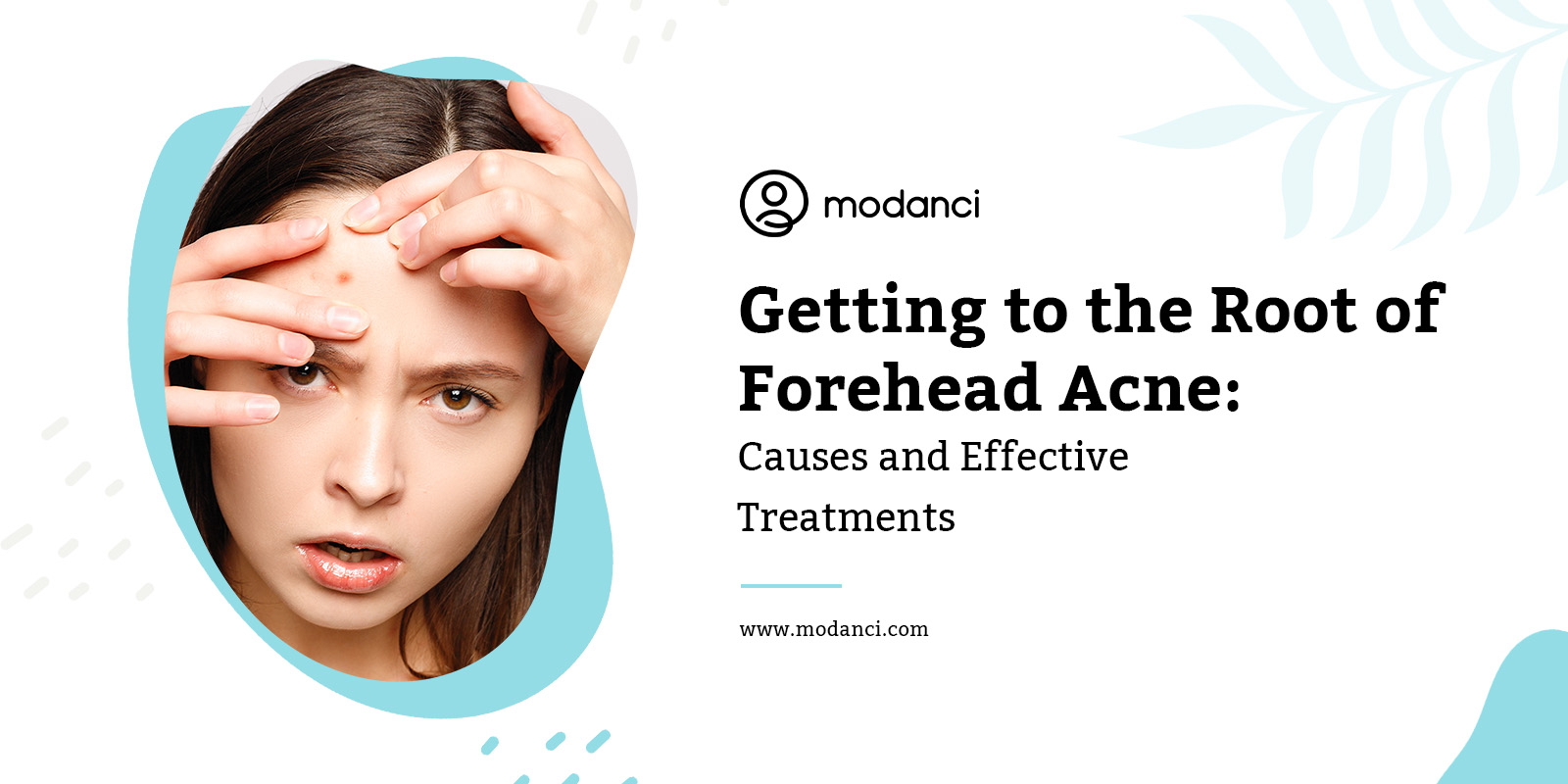Do you observe small red bumps on your forehead? Do they occasionally release whitish pus? Acne might be the underlying cause.
Acne commonly appears on the forehead area, primarily because the skin on the forehead tends to be oilier compared to the rest of the face. Forehead acne is characterised by inflammation of the skin on the forehead due to clogged hair follicles and oil glands. This occurs when the oil glands in the forehead produce an excess amount of sebum. The surplus sebum traps dead skin cells and bacteria within the follicles and oil glands on the forehead.
The most prevalent types of acne found on the forehead are blackheads and papules. Occasionally, other types, such as pustules and cysts, may also appear. However, you can easily treat forehead acne with home remedies that have no side effects. Let’s explore the causes of forehead acne in more detail and learn how to prevent it.
Causes of Forehead Acne
There are various factors that can contribute to an increased production of sebum by the sebaceous glands, which in turn increases the likelihood of developing acne and pimples. These factors include:
1. Hormonal changes
During puberty, hormone levels fluctuate significantly, making acne particularly common during this period.
2. Stress
While the exact reasons are unclear, there is a connection between stress and acne outbreaks.
3. Medication
Certain medications, such as certain steroids, anticonvulsants, barbiturates, or lithium, can have acne as a side effect.
4. Hygiene
Failing to regularly wash the hair and face can lead to the accumulation of oily deposits on the forehead and blockages that contribute to acne formation.
5. Hair products
Certain hair products like gels, oils, or waxes can cause a type of acne known as pomade acne.
6. Skin irritation
Applying makeup on the forehead or wearing hats can irritate the skin, leading to acne. Additionally, frequent touching of the forehead can aggravate the skin and trigger acne.
What does Ayurveda say?
According to Ayurveda, the balance of three vital energies, Vata, Pitta, and Kapha doshas, is essential for the proper functioning of the body. When these energies are imbalanced, it can lead to various abnormalities, including skin conditions.
In Ayurveda, the forehead region is associated with the Vata dosha, which is connected to the nervous and digestive systems. An imbalance in the Vata dosha in these systems is believed to be the cause of acne on the forehead.
When the Vata dosha is imbalanced, the skin on the forehead becomes excessively dry. To combat this dryness, the Pitta and Kapha doshas, which regulate fluids in the body, become aggravated. This increased Pitta and Kapha dosha levels result in a hormonal imbalance, leading to the overproduction of sebum in the oil glands and follicles.
The excess sebum-filled glands and follicles attract pollutants, dead skin cells, and bacteria, leading to the formation of acne on the forehead.
Different characteristics of forehead acne can indicate specific dosha imbalances. Dry acne without pus is often associated with excess Vata dosha. Red, inflamed, and sore acne indicates an aggravated Pitta dosha. Pus-filled acne is usually attributed to an elevated Kapha dosha.
Several factors can contribute to an imbalance in the Vata dosha, including an improper diet, high stress levels, anxiety, constipation, and inadequate blood circulation to the skin, resulting in a lack of nutrient supply.
Natural Solutions for Forehead Acne
To naturally eliminate acne on your forehead, it is important to determine which imbalanced doshas are present in your body. Once identified, you can select herbal remedies that can be applied externally or consumed internally. These remedies aim to calm the aggravated doshas, restoring balance to your overall well-being.
1. Aloe vera
Aloe vera is a beneficial treatment for inflamed and painful pimples. For best results, use aloe vera directly extracted from the plant. Its antibacterial properties effectively treat and reduce redness while speeding up the healing process of pimples. Aloe vera’s antifungal characteristics also make it effective for treating boils and cysts. Acting as an astringent, it helps remove excess oil from pimples. Regular daily application of aloe vera can also help lighten acne scars.
2. Turmeric and honey
- Turmeric has anti-inflammatory properties that help reduce the size of pimples and control excess oil on the skin. Honey acts as a bacteria-fighting agent and has antimicrobial properties. Mix 1⁄2 teaspoon of turmeric with 1 tablespoon of honey, ensuring thorough blending.
- Apply the mixture to damp skin and leave it on for five minutes before rinsing off with water.
3. Giloy (Tinospora Cordifolia)
Giloy (Tinospora Cordifolia) helps balance all three doshas.
To prepare a paste,
- mix ¼ teaspoon of giloy juice, ⅛ teaspoon of turmeric powder, and ⅛ teaspoon of neem powder.
- Apply the paste on your forehead and wash it off after 30-45 minutes.
- For optimal results, repeat this process three times a week.
4. Neem (Azadirachta Indica)
Neem (Azadirachta Indica) balances Kapha and Pitta doshas.
- Take 10-12 neem leaves and 2-3 teaspoons of aloe vera gel, grind them together to create a smooth paste.
- Add 5-8 drops of neem oil to the paste and apply it as a facial mask to address your acne issues.
5. Chickpea flour
Chickpea flour, also known as gram flour, is a natural remedy for acne, particularly for people with oily skin. It effectively reduces oiliness by absorbing excess sebum.
- Mix one tablespoon of chickpea flour with rose water. water,
- Apply the mixture to clean the skin.
- Leave it on for 10 minutes before rinsing off.
6. Lime juice
Lime juice has antibacterial properties that help eliminate pimples by targeting the bacteria responsible for their formation. Additionally, its high vitamin C and citric acid content can gradually improve skin brightness.
- Apply lime juice directly to the pimple using a cotton pad.
- Allow it to sit for 5-10 minutes before rinsing off.
7. Yoghurt
Yoghurt contains lactic acid, which helps remove dead skin cells, and its live cultures have antibacterial properties that promote clear skin.
- Apply 1⁄4 cup of organic, plain yoghurt to your face using a small brush.
- Let it dry for 10 minutes before rinsing off.
Additionally, maintaining a healthy gut by regularly consuming yoghurt can help treat acne and improve overall skin health.
8. Cinnamon (Cinnamomum Verum)
Cinnamon (Cinnamomum Verum) helps balance Vata and Kapha doshas.
- Combine 2 teaspoons of cinnamon powder with 1 teaspoon of honey.
- Apply the mixture on your forehead acne and rinse it off after 30 minutes.
Additionally, regularly including cinnamon in your diet can help lower insulin levels in your blood, which in turn controls oil production on your forehead.
9. Almonds
Almonds are nutrient-dense and contain minerals and Vitamin E, making them valuable for various facial scrubs and masks. Incorporating almonds into your skincare routine can help rejuvenate the skin.
- Blend almonds in a blender and mix them with water or other fruits.
- Apply the mixture as a mask or use it as a targeted treatment for pimples, leaving it on for a maximum of 30 minutes.
Dietary Advice for Forehead Acne
Maintaining a balanced diet is crucial for maintaining equilibrium in your doshas and also has a direct impact on your skin, including forehead acne. Certain foods with a high glycemic index can lead to increased insulin levels in your body, which in turn stimulates excess oil production in the skin.
Therefore, it is advisable to avoid consuming:
- Junk foods and Oily food items
- Bakery Items
- Pasta and Noodles
- Spicy food
- White rice
- Fermented foods
- Beverages with added sugar
- Starchy vegetables like potatoes.
To help reduce forehead acne, it is recommended to include the following foods in your diet regularly:
- Vegetables like carrots, sweet potatoes, spinach, tomatoes, and other dark green leafy vegetables.
- Citrus fruits like Oranges and sweet limes and antioxidant-rich berries like blueberries and apricots.
- Nuts like walnuts and almonds.
- Seeds such as flax seeds, mustard seeds, and pumpkin seeds.
- Fatty fish like sardines, mackerel, and salmon.
- Whole grains like wild rice and brown rice.
- Legumes such as beans, navy beans, lentils, and peas.
Including these foods in your diet can be beneficial for reducing forehead acne and promoting healthier skin.
Preventing Forehead Acne
Here are some tips on how to prevent forehead acne:
- Cleanse your face with lukewarm water and a neem herbal cleanser every morning, evening, and night before bed. Use a gentle scrub to massage your forehead daily to remove excessive sebum.
- Keep your hands clean by washing them regularly, and avoid touching your face or forehead with your hands.
- Avoid leaving sweat on your face for too long, and carry a gentle face wash with you for cleansing purposes.
- Be cautious of using heavy hair products that can worsen forehead acne when they come into contact with your face.
- Stay away from harsh skincare products that can cause excessive dryness, as dehydrated skin may trigger increased sebum production.
- Avoid using skin products that contain heavy oils, as they can make your forehead more oily and greasy.
- Avoid wearing tight-fitting headgear, especially ones that cover your forehead.
- Always remove makeup before going to sleep.
Conclusion
To maintain healthy and acne-free skin, it’s crucial to adopt a holistic approach that includes a proper skincare routine, a balanced diet, and healthy lifestyle habits. Incorporating regular exercise can also promote better blood circulation, which aids in faster healing of acne.
At Modanci, we offer personalised Ayurvedic skincare solutions tailored to your skin’s specific requirements and aligned with your unique prakruti (constitution).
FAQs
1. Why do some people get acne, specifically on their forehead?
Forehead acne refers to the inflammation of the skin on your forehead caused by the blockage of hair follicles and oil glands. This occurs when the oil glands in the forehead produce an excessive amount of sebum. The surplus sebum traps bacteria and dead skin cells within the follicles and oil glands located on the forehead.
2. Are there any common causes of forehead acne?
Common causes for Forehead Acne include stress levels, hormones, puberty, certain medications, some hair products and irritation from some clothing or headgear.
3. Can certain hair products or styling practices contribute to forehead acne?
Forehead acne can be caused by your hair as well. Insufficient hair washing or having oily hair can result in oil being deposited on your forehead, leading to clogged pores.
Additionally, breakouts on the forehead can be attributed to the usage of certain hair products. Hair styling and straightening products, such as pomades, oils, gels, and waxes, are notorious for causing acne. These products often contain ingredients like cocoa butter or coconut oil, which can make your skin excessively oily. This type of acne caused by hair products is called pomade acne.
4. How can diet and lifestyle factors affect forehead acne?
An overall healthy body and mind are bound to reflect through a glowing skin. Maintaining a balanced diet is crucial for maintaining equilibrium in your doshas and directly impacts your skin, including forehead acne. Certain foods with a high glycemic index can lead to increased insulin levels in your body, which in turn stimulates excess oil production in the skin. Exercise has been proven to positively affect blood circulation and, in turn, your acne.
Read More:




